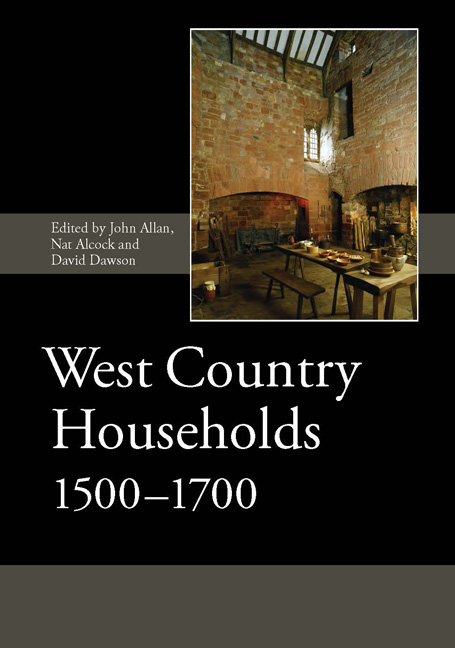Book contents
- Frontmatter
- Dedication
- Contents
- List of Illustrations
- List of Contributors
- List of Abbreviations
- Introduction
- I The Form and Development of West Country Houses
- II The Decoration of West Country Houses
- III The Material Culture of West Country Households
- 10 Culinary Artefacts in West Country Households, 1550–1700: Form, Function and Nomenclature
- 11 The Archaeology of the West Country Bronze Foundries
- 12 Cast Bronze Cooking Pots in England, 1500–1720
- 13 Table Glass in the West Country Home, c. 1500–1700
- 14 Portuguese Faience in South-West England
- 15 Dinner on the Ceiling: the 17th-Century Plasterwork at 144 Fore Street, Exeter
- 16 Pots and Texts: Understanding Pots in Use
- 17 Presenting an Elizabethan Interior: the Reinterpretation of St Nicholas Priory, Exeter
- Index of People and Places
- Index of Subjects
13 - Table Glass in the West Country Home, c. 1500–1700
from III - The Material Culture of West Country Households
Published online by Cambridge University Press: 05 May 2015
- Frontmatter
- Dedication
- Contents
- List of Illustrations
- List of Contributors
- List of Abbreviations
- Introduction
- I The Form and Development of West Country Houses
- II The Decoration of West Country Houses
- III The Material Culture of West Country Households
- 10 Culinary Artefacts in West Country Households, 1550–1700: Form, Function and Nomenclature
- 11 The Archaeology of the West Country Bronze Foundries
- 12 Cast Bronze Cooking Pots in England, 1500–1720
- 13 Table Glass in the West Country Home, c. 1500–1700
- 14 Portuguese Faience in South-West England
- 15 Dinner on the Ceiling: the 17th-Century Plasterwork at 144 Fore Street, Exeter
- 16 Pots and Texts: Understanding Pots in Use
- 17 Presenting an Elizabethan Interior: the Reinterpretation of St Nicholas Priory, Exeter
- Index of People and Places
- Index of Subjects
Summary
This paper examines selected groups of excavated table glass from the three urban centres of Exeter, Poole and Plymouth. By examining the changes in provenance and range of forms present it is possible to chart the evolving patterns of consumption taking place in the West Country home during the 16th and 17th centuries. As well as growing competition between the emerging European centres of production, innovations in style, technological advances and developing patterns of trade can all be seen to have affected directly the consumer choices of the emerging middling sort.
INTRODUCTION
The detailed examination of 16th- and 17th-century vessel glass has a relatively short pedigree, and it has only been in the last quarter of a century that a greater appreciation of the range and numbers of vessels used in England has developed. Since relatively few glasses dating to this period have survived in art historical collections, it is only through the study of the growing corpus of excavated archaeological material that is it possible to gain a more sophisticated appreciation of the patterns of consumption of early postmedieval glass. The late Robert Charleston was the pioneer of this process, studying many of the key assemblages excavated in the 1970-80s, and publishing in 1984 English Glass and the Glass Used in England circa 400–1940. Although a more detailed survey of the archaeological evidence for glass of this period has been produced more recently, this, like Charleston's book, remains in practice a synthetic work, largely dealing with the individual vessel types in isolation and removed from their contextual background.
Despite this growth in the number of specialist reports in recent years, to date there have been no wider regional surveys of archaeological glass. Whilst many specialist studies, such as Courtney's 2004 report on Acton Court, have provided fully contextualized examination of the glass and even contributed to the wider site narrative, this format only really allows for a relatively restricted intra-, rather than inter-, site analysis.
- Type
- Chapter
- Information
- West Country Households, 1500–1700 , pp. 321 - 338Publisher: Boydell & BrewerPrint publication year: 2015



